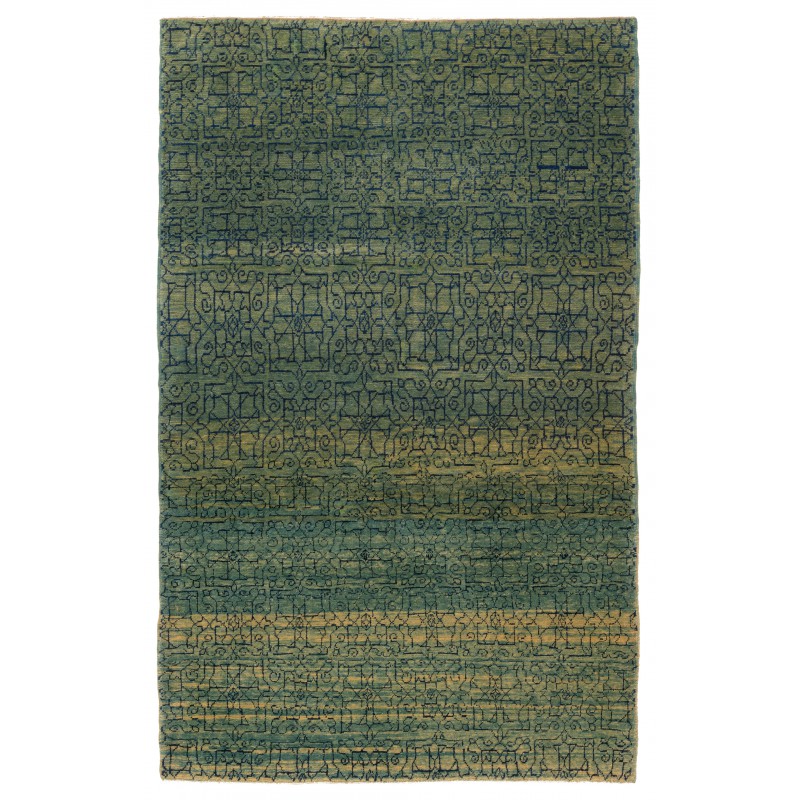
- Stock: 売り切れ
- Model: C50282
- サイズ: 104cm x 166cm
この絨毯の情報源はエンドレ・ウンガーの所有物であり、1992年にサザビーズで売却されました。この中央に星のある絨毯は、エジプトのカイロにあるマムルーク・スルタンの手によって16世紀初頭にデザインされたものです。解釈されたデザインは、ジェレヒアン絨毯のボーダーモチーフの格子状が、エレガントにフィールドを覆っています。マムルーク絨毯は、イスラム世界のほとんどの絨毯織り地域に共通の、豊富な境界地の牧草地と涼しい冬の温暖な気候の組み合わせがない物理的な環境で生まれました。北に位置するアナトリアを中心とした広範なトルコ織りの伝統と関連がありながらも、これらの絨毯のデザインには、エジプトの伝統に深く根ざした様式化されたパピルス植物など、非典型的な要素が含まれています。彼らの特異な構成とレイアウトは、おそらく「マムルークブランド」を築き上げることができる独自の製品を開発しようとする試みを表しているのでしょう。非典型的なカラースキームは、未染の白いパイルを欠き、3色または5色の範囲が同じくらいの値で使用されることからも、特定のスタイルのアイデンティティを創り出そうという意図があったことを示唆しています。また、イスラムの絨毯の世界ではほとんど例を見ないS-撚りのウールも特徴的です。これは、亜麻繊維をリネン糸に紡ぐというエジプトの先行する伝統によって、時計回りのウールの紡績がエジプトで起源を持つと主張されています。植物の植物学的構造の詳細からは、ウールと綿のために中東全体で広く使用されている反時計回りの紡績が予想されますが、亜麻繊維を紡ぐことは不可能です。
シモネッティの色の組み合わせを持つマムルーク絨毯は、現在では一般的にアナトリア、イラン、シリアの織りに多くのつながりを持つ、より早い伝統の一部として受け入れられています。メトロポリタン美術館のコレクションにもよく見られる「3色」のマムルーク絨毯は、エジプトが1517年にオスマン帝国に征服された後も長く続いた後の発展を示しています。これらの絨毯の多くは17世紀に入っても生産されていた可能性がありますし、それ以上にも生産されていたかもしれません。(ウォルター・B・デニー、[エフティアール、スーチェク、キャンビー、ハイダー2011]参照)。
この絨毯のデザインは、私たちのマムルークタイプの絨毯コレクションからのデザイナーによって解釈され、ソフトな色が使用されています。
The source of the rug comes from the possession of Endre Unger, which was sold at Sotheby’s in 1992. That rug with the central star was designed in the early 16th-century rug by Mamluk Sultane of Cairo, Egypt. The interpreted design is composed of Jerrehian rug’s border motifs lattice, covering the field elegantly. Mamluk carpets originated in a physical environment that lacked the combination of abundant marginal grazing land and a temperate climate with cool winters that were common to most carpet-weaving areas in the Islamic world. While related to a broader tradition of Turkish weaving centered in Anatolia, far to the north, the designs of these carpets include atypical elements, such as stylized papyrus plants, that are deeply rooted in Egyptian tradition. Their unusual composition and layout probably represent an attempt to develop a distinctive product that could in effect establish a “Mamluk brand” in the lucrative European export market. The uncharacteristic color scheme—devoid of the undyed white pile and employing a limited range of three or five hues in much the same value—also suggests a conscious attempt to create a particular stylistic identity. Also virtually unique in the world of Islamic carpets is the S-spun wool. It has been argued that the tradition of clockwise wool spinning originated in Egypt because of the earlier Egyptian tradition of spinning flax into linen thread. Details of the plant’s botanical structure make it impossible to spin flax fiber in the more common counterclockwise direction utilized throughout the Middle East for wool and cotton.
全部で3色使っています。
- Emerald Green 407 (カモミール - 藍)
- Gunmetal Blue 409 (藍)
- Pale Green 439 (カモミール - 藍)
上の番号は私たちのカラーコードです。()の中は、主な草木染めの材料です。
